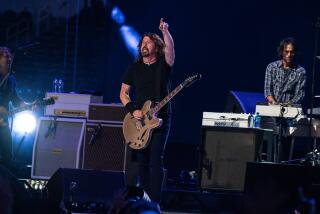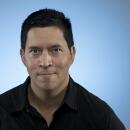Sundance 2013: ‘Sound City’ rocks Park City
- Share via
PARK CITY, Utah — At the world premiere of his directorial debut, the rockumentary “Sound City,” Foo Fighters frontman and ex-Nirvana drummer Dave Grohl made an admission that’s sure to come as a surprise the millions of head-bangers who have thrilled to his music.
“I consider this to be the most important thing I’ve ever done artistically,” Grohl said, just before the lights went down in the theater.
If you have enjoyed FM radio pop music at any point in the last 40 years, songs created at Van Nuys’ legendary Sound City Studios almost certainly hold a cherished position in your music collection. As detailed in a recent Times profile of Grohl, the grungy space served as a creative hothouse for an eclectic array of artists spanning hippie to country to post-punk that includes Fleetwood Mac, Rage Against the Machine, Barry Manilow, Neil Young, Weezer, the Grateful Dead, Johnny Cash, Nine Inch Nails, Van Halen, Tom Petty and Pat Benatar. Drummer-guitarist-singer-songwriter Grohl makes clear in the film that feels he would have never developed into the musician he became if not for having recorded Nirvana’s breakthrough 1991 album “Nevermind” at Sound City.
Throughout the screening, audience members nodded their heads in time with the immortal pop songs onscreen and you could feel the vibration of feet tapping on the auditorium floor. It went on to receive three bursts of applause before the final credits rolled and Grohl got a standing ovation as the lights went up.
A key part of the movie’s narrative involves explaining the deus ex machina quality imbued by recording on Sound City’s custom-designed Neve console, an analog mixing board widely thought to have given such landmark albums as Petty’s “Damn the Torpedoes,” Fleetwood Mac’s eponymous 1975 LP and Rage Against the Machine’s debut added warmth, depth and soul. Blame for the studio’s 2011 demise in the film seems to be hung squarely on the rise of digital technology that allows artists to creatively cut corners in ways that would have been unthinkable in Sound City’s bygone musical era.
In remarks after the screening Friday, however, Grohl attempted to make clear that “Sound City” was not intended as a repudiation of modern recording technologies.
“There’s a misconception that the movie is about analog versus digital,” Grohl said. “It’s part of the discussion but it’s not the heart of the movie. Human beings and what happens when they make music together — you can capture that with computers. Computers don’t kill bands. It’s the producers that usually do.”
Asked if the film marked a new career path, Grohl indicated he had no future movie plans.
“I don’t know. The first Foo Fighters record, I just did for fun and that was 20 years ago,” he said. “This project, I can’t imagine ever doing anything else like it. I was so close to the subject. I couldn’t make a movie about … Whole Foods, you know?”
Having debuted his initial public offering as a filmmaker, Grohl put a different facet of himself on conspicuous display later that evening in Park City: fervent rock ‘n’ roll cheerleader.
“Sound City” features the Foo Fighter jamming and songwriting with a super group of platinum-certified performers such as Paul McCartney and Trent Reznor — a collective known as the Sound City Players -- committing the fruit of their labor to two-inch tape on the Neve console, now relocated to Grohl’s Studio 606 in the San Fernando Valley. Several of those artists made the schlep up to Utah. And the 800 fans who braved the frigid 7-degree temperature to stand in a long line to get into the Park City Live venue Friday night were rewarded with a 3-hour and 10-minute cavalcade of classic rock.
It was an unforgettable night even by Sundance’s starry standards.
After running through a suite of heavy grunge songs with the multi-instrumentalist/producer Alain Johannes, accompanied by a backing band comprised of the other Foo Fighters, Grohl welcomed to the stage Lee Ving, lead vocalist for the L.A. punk rock outfit Fear — the group that made Grohl want to make a career in rock in the first place. His short set (with drumming contributed by Rage Against the Machine percussionist Brad Wilk) was hard rocking, raucous and rowdy, causing some Sundance attendees to head for the exits.
Ving and Wilk were soon supplanted by flamboyant Cheap Trick guitarist Rick Nielsen and Slipknot frontman Corey Taylor with Nirvana’s Krist Novoselic handling bass-playing duties. The super group’s version of Cheap Trick’s anthemic “Surrender” provided a high point of the evening. Then ‘80s rock poster boy Rick Springfield took the stage to run through his hard-edged Sound City Players number “The Man Who Never Was” before delivering blistering renditions of his massive hits “I’ve Done Everything for You” and “Jessie’s Girl,” whipping the crowd into a veritable frenzy.
As he exited the stage, John Fogerty strapped on a guitar to a burst of sustained applause and proceded to rock harder than any 67-year-old has any reasonable expectation to. He ripped through such unassailable Credence Clearwater Revival classics as “Bad Moon Rising,” “Born on the Bayou” and “Fortunate Son” in addition to his solo hit “Centerfield.”
While various Foo Fighters came and left the stage, Grohl remained as a constant, introducing each Sound City Player with flattering remarks, alternating between guitar, bass and drums and generally exhorting near-ecstatic performances by all of them.
Just as the audience threatened to lose steam, Grohl introduced “rock ‘n’ roll’s queen,” Stevie Nicks. Before launching into “We Can’t Fix This,” the song she wrote as a Sound City Player, the Fleetwood Mac doyenne explained the song was about the death of her godson, a subject she had never publicly addressed before.
Nicks bewitched the crowd with an intimate performance of standouts from her epochal catalog of hits, including her Tom Petty duet “Stop Draggin’ My Heart Around” (with Grohl substituting for the lead Heartbreaker) the Fleetwood Mac songs “Dreams,” “Gold Dust Woman” and an achingly delicate version of “Landslide.”
It was nearly 1 a.m. when the audience was dispatched onto Main Street, ebullient, spent and hoarse from cheering.
ALSO:
Sundance darlings eye alternative distribution platforms
Critic’s Notebook: Whatever Sundance is, it has fine documentaries
Sundance 2013: From Kutcher to Pussy Riot, five storylines to watch
Twitter: @chrislee
MORE SUNDANCE COVERAGE
VIDEO: A video guide to Sundance 2013
More to Read
Only good movies
Get the Indie Focus newsletter, Mark Olsen's weekly guide to the world of cinema.
You may occasionally receive promotional content from the Los Angeles Times.











